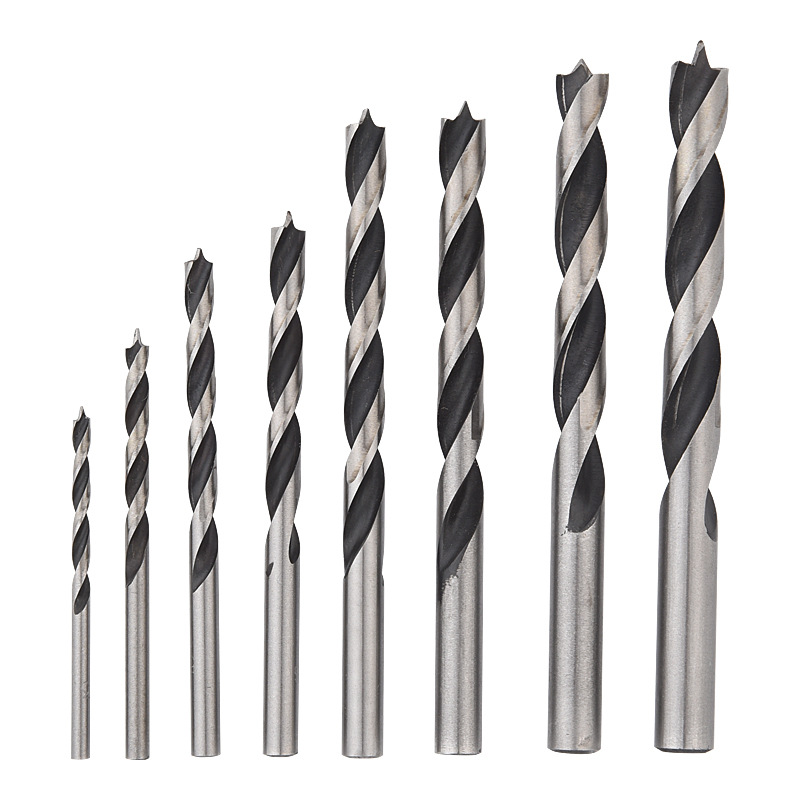The Ultimate Guide to Brad Point Drill Bits: Precision Redefined for Woodworkers
Precision Personified: Anatomy of a Brad Point Bit
Unlike conventional twist bits that wander on contact, brad point drill bits feature a revolutionary three-part tip architecture:
- Center Spike: A needle-like point that pierces wood grain for zero-wander starts
- Spur Blades: Razor-sharp outer cutters that slice wood fibers before drilling, eliminating tear-out
- Primary Lip: Horizontal cutting edges that efficiently remove material
This trifecta delivers surgically accurate holes—critical for dowel joints, hinge installations, and visible joinery.
Table: Brad Point vs. Common Wood Biting
| Bit Type | Tear-Out Risk | Max Precision | Best Use Case |
|---|---|---|---|
| Brad Point | Very Low | 0.1mm tolerance | Fine furniture, dowels |
| Twist Bit | High | 1-2mm tolerance | Rough construction |
| Spade Bit | Moderate | 3mm+ tolerance | Rapid large holes |
| Forstner | Low (exit side) | 0.5mm tolerance | Flat-bottom holes |
| Source: Industry testing data 210 |
Engineering Excellence: Technical Specifications
Premium brad point bits combine specialized metallurgy with precision grinding:
- Material Science: High-speed steel (HSS) dominates the premium segment, with some titanium-nitride coated variants for extended life. HSS retains sharpness 5x longer than carbon steel under friction heat .
- Groove Geometry: Twin spiral channels evacuate chips 40% faster than single-flute designs, preventing clogging in deep holes .
- Shank Innovations: 6.35mm (1/4″) hex shanks enable slip-free chuck gripping and quick changes in impact drivers .
Table: Bosch RobustLine HSS Brad Point Specifications
| Diameter (mm) | Working Length (mm) | Ideal Wood Types | Max RPM |
|---|---|---|---|
| 2.0 | 24 | Balsa, Pine | 3000 |
| 4.0 | 43 | Oak, Maple | 2500 |
| 6.0 | 63 | Hardwood laminates | 2000 |
| 8.0 | 75 | Exotic hardwoods | 1800 |
Why Woodworkers Swear By Brad Points: 5 Undeniable Advantages
- Zero-Compromise Accuracy
The centering spike acts like a CNC locator, achieving positional accuracy within 0.5mm even on curved surfaces 5. Unlike Forstner bits that require pilot holes, brad points self-locate. - Glass-Smooth Bore Walls
Spur blades score the hole circumference before drilling, resulting in finish-ready holes that need no sanding—a game-changer for exposed joinery . - Deep Hole Superiority
The 75mm+ working length on 8mm bits (with 300mm extenders available) allows drilling through 4×4 lumber in one pass. Chip-clearing grooves prevent binding . - Cross-Material Versatility
Beyond hardwoods and softwoods, quality HSS brad points handle acrylics, PVC, and even thin aluminum sheets without chipping . - Lifecycle Economy
Though 30-50% pricier than twist bits, their regrindability makes them lifetime tools. Professional sharpeners charge $2-5/bit for restoration .
Mastering the Bit: Pro Techniques and Pitfalls
Speed Secrets
- Hardwoods (oak, maple): 1,500-2,000 RPM for bits under 10mm
- Softwoods (pine, cedar): 2,500-3,000 RPM for clean entry ;
- Diameter >25mm: Drop below 1,300 RPM to prevent edge chipping .
Exit Blowout Prevention
- Place sacrificial board under workpiece
- Reduce feed pressure when tip emerges
- Use Forstner bits for holes exceeding 80% material thickness.
Maintenance Rituals
- Clean resin buildup with acetone immediately after use.
- Store in PVC sleeves to prevent edge dings .
- Hand-sharpen spurs with diamond needle files—never bench grinders.
Post time: Aug-03-2025
